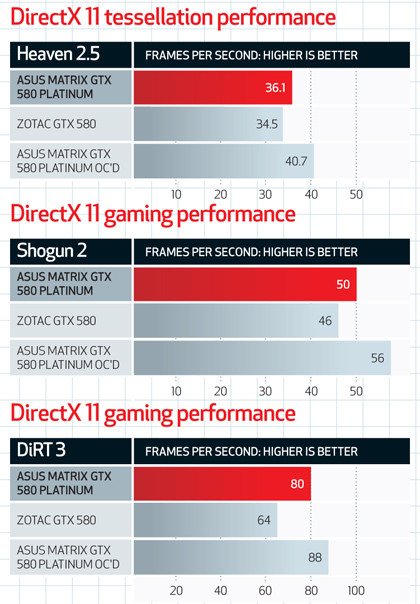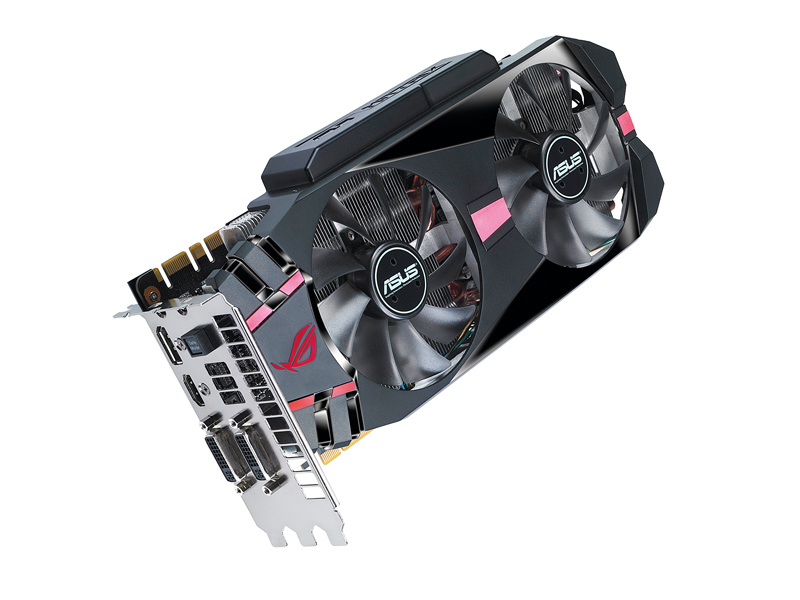TechRadar Verdict
Pros
- +
Great build quality
- +
Almost twin-GPU performance
- +
Stunning load temps
Cons
- -
Horribly loud
Why you can trust TechRadar
Nvidia's GTX 580 is one high performance piece of silicon. Not only does it iron out the problems of the initial Fermi release – the GTX 480 – it builds upon that sturdy architecture with more CUDA cores and faster clock speeds.
Since the GTX 590 prices itself out of mainstream contention, the GTX 580 is the go-to DX11 performance card. It's also a card that third-party manufacturers have been working pretty hard to improve. So how does the Asus Republic of Gamers Matrix GTX 580 Platinum measure up?
Asus has a good track record with the GTX 580: its DirectCU II model proved the superior effort of all manufacturers' tweaked reference GTX 580s. The Platinum costs a tad more than the DirectCU II, and as the opulent name suggests, it's even riper with performance tweaks, features and overclocking potential.
For your £400, the improvements on Nvidia's stock GTX 580 are quite drastic. Notably, Asus has fitted a three-piece cooler to a custom PCB equipped with the GPU. It occupies three slots and sports a LED load display and safe mode button, for when you've pushed the settings a bit too far.
Robust republican
There's more than flashy lights on offer here, though. The Matrix GTX 580 Platinum is constructed with 19 phase super alloy components to make it more robust to higher voltages right off the bat.
Two huge heatsinks and two huge fans greatly improve on the heat management of the stock GTX 580. In fact, load temperatures are halved with Asus' card. Our reference GTX 580 runs at 74ºC rendering the Heaven 2.5 benchmark. The Matrix GTX 580 Platinum does it at 47ºC – even at sky-high clock settings.
Sign up for breaking news, reviews, opinion, top tech deals, and more.
Unfortunately, it's also deafeningly loud, especially when you push the '100%' button on board that optimises everything for overclocking.
Clocking it
It's safe to say this is an overclocker's card. The robust components, beefy cooling and on-card controls all lead to that conclusion. With that in mind then, The Matrix GTX 580 Platinum lives and dies on how far it can be pushed in practice.
Lucky it overclocks so damn well, then. Out of the box, it's noticeably quicker than a stock GTX 580. The core clock's running at 816MHz to the stock's 772MHz, and the shaders are up from 1544MHz to 1632MHz too. That equates to three to five more frames per second in-game.
Once you start overclocking with the 'GPU Tweak' utility, though, the card's wild side is unleashed. A stock GTX 580 can be pushed up to around 880MHz core clock, and 2,100MHz memory. We got the Matrix GTX 580 Platinum's core clock running stable at 945MHz with the memory at 2,250MHz. Again, in-game, that results in some of the quickest performances we've ever seen, bordering on the twin-GPU GTX 590's chops.
Tech Labs


And for almost £200 less, that's something of a revelation. You will have to work to get this level of performance out of the Matrix GTX 580 Platinum, but it's there. And in this weird chasm of a price point between the £300 GTX 580 and the £600 GTX 590, it almost seems like good value.
Follow TechRadar Reviews on Twitter: http://twitter.com/techradarreview

Ad creative by day, wandering mystic of 90s gaming folklore by moonlight, freelance contributor Phil started writing about games during the late Byzantine Empire era. Since then he’s picked up bylines for The Guardian, Rolling Stone, IGN, USA Today, Eurogamer, PC Gamer, VG247, Edge, Gazetta Dello Sport, Computerbild, Rock Paper Shotgun, Official PlayStation Magazine, Official Xbox Magaine, CVG, Games Master, TrustedReviews, Green Man Gaming, and a few others but he doesn’t want to bore you with too many. Won a GMA once.
